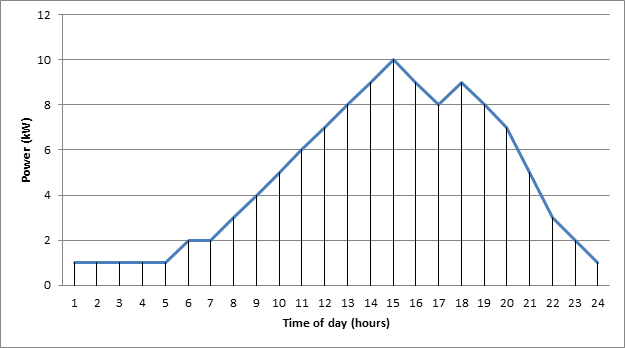Power
and energy are two key metrics for characterizing a storage system (Eyer &
Corey, 2010) .
Power is the instantaneous measurement of the use of electricity or the rate at
which electric energy is consumed. Power is expressed in watts or more
commonly, in the context of utility supplied electric energy, kilowatts (1000
watts, commonly written as kW) or megawatts (106 watts, commonly
written as MW). Energy is the amount of power consumed, expressed in watt-hours
or more commonly kilowatt-hours (1000 watt-hours commonly written as kWh) (Miller, 2012) . On a very large
scale energy is expressed in megawatt-hours (106 watts-hours
commonly written as MWh) but kWh is a more common unit of energy as kWh more
closely matches electricity consumption and utility pricing (NSTAR, 2012) .
Mathematically
the relationship between electric energy and power is :
Power = Energy /
Time
Energy = Power X
Time
To see the
relationship graphically, consider Figure
1,
which could be a hypothetical load curve showing the power consumed by a
household (in kW) throughout a 24 hour day. Each point on the curve indicates
the instantaneous power consumed at a specific time, with a peak of 10 kW at
3pm. The area under the curve is the amount of energy consumed during the 24
hour period, in this case 113 kWh.
Figure 1 Hypothetical load curve showing Power (kW)
vs. Time of day (hours).
Consider that Figure
1
could also be a graph showing the power output of an energy storage device
during a 24 hour period. During this 24 hour period the energy storage device outputs
a maximum power of 10 kW at 3pm and discharges a total of 113 kWh of energy.
Under normal operating conditions the storage system’s maximum power output
would be the “Nameplate Power Rating”
(DOE, 2010) .
Some energy storage technologies have the short term, emergency capability of
discharging at power rates 1.5 to 2 times their nameplate power rating. The value of this capability, referred to as
the equipment’s “Emergency Rating”,
can often offset the reduced efficiency and storage equipment damage incurred
by this above nominal burst of power (Eyer & Corey, 2010) .
The amount of time that an energy
storage technology can discharge at its nameplate power rating, before requiring
a recharge, is the “Discharge Duration”.
Multiplied by the power rating of the device, this is the amount of energy that
the storage device can produce. If the energy storage technology, whose power
output curve is represented in Figure 1,
has a nameplate power rating of 10 kW and a discharge duration of 12 hours, the
energy storage device can produce 120 kWh of energy before requiring a
recharge. Figure
1
demonstrates a valuable advantage of an energy storage device over traditional
power generation equipment. Unlike a traditional generator, most energy storage
technology can discharge at significantly variable rates, below its nameplate
power rating, without incurring significant inefficiency or equipment damage (Baxter, 2006) .
<< Cost of Energy Storage Time Dependent Parameters>>
Works Cited
Baxter, R. (2006). Energy Storage; A Nontechnical
Guide. Tulsa, Oklahoma: PennWell Corporation.
DOE. (2010, November 12). Discussion of Data for
Smart Grid Metrics and Benefits; Storage System Performance Supplement. Retrieved
December 2, 2012, from
http://www.smartgrid.gov/sites/default/files/pdfs/energy_storage_system_performance_supplement.pdf
Eyer, J., & Corey, G. (2010). Energy Storage
for the Electricity Grid: Benefits and Market Potential Assessment Guide.
Albuquerque, New Mexico: Sandia National Laboratories.
Miller, K. (2012, October 26). How To Speak Data
Center: Power vs. Energy. Retrieved December 2, 2012, from Network
Computing:
http://www.networkcomputing.com/data-center/how-to-speak-data-center-power-vs-energy/240010565
NSTAR. (2012). Residential > Rates &
Tariffs > Basic Service. Retrieved December 2, 2012, from NSTAR:
http://www.nstar.com/residential/rates_tariffs/basic_service.asp

Thanks for sharing useful information. If you are looking for the best energy storage companies then choose us to get the solutions for Home Battery Storage Ontario , Canada.
ReplyDelete